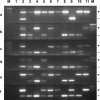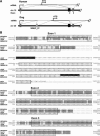Short interspersed elements (SINEs) are a major source of canine genomic diversity
- PMID: 16339378
- PMCID: PMC1356118
- DOI: 10.1101/gr.3765505
Short interspersed elements (SINEs) are a major source of canine genomic diversity
Abstract
SINEs are retrotransposons that have enjoyed remarkable reproductive success during the course of mammalian evolution, and have played a major role in shaping mammalian genomes. Previously, an analysis of survey-sequence data from an individual dog (a poodle) indicated that canine genomes harbor a high frequency of alleles that differ only by the absence or presence of a SINEC_Cf repeat. Comparison of this survey-sequence data with a draft genome sequence of a distinct dog (a boxer) has confirmed this prediction, and revealed the chromosomal coordinates for >10,000 loci that are bimorphic for SINEC_Cf insertions. Analysis of SINE insertion sites from the genomes of nine additional dogs indicates that 3%-5% are absent from either the poodle or boxer genome sequences--suggesting that an additional 10,000 bimorphic loci could be readily identified in the general dog population. We describe a methodology that can be used to identify these loci, and could be adapted to exploit these bimorphic loci for genotyping purposes. Approximately half of all annotated canine genes contain SINEC_Cf repeats, and these elements are occasionally transcribed. When transcribed in the antisense orientation, they provide splice acceptor sites that can result in incorporation of novel exons. The high frequency of bimorphic SINE insertions in the dog population is predicted to provide numerous examples of allele-specific transcription patterns that will be valuable for the study of differential gene expression among multiple dog breeds.
Figures



References
-
- Batzer, M.A. and Deininger, P.L. 2002. Alu repeats and human genomic diversity. Nat. Rev. Genet. 3: 370-379. - PubMed
-
- Bentolila, S., Bach, J.M., Kessler, J.L., Bordelais, I., Cruaud, C., Weissenbach, J., and Panthier, J.J. 1999. Analysis of major repetitive DNA sequences in the dog (Canis familiaris) genome. Mamm. Genome 10: 699-705. - PubMed
-
- Borodulina, O.R. and Kramerov, D.A. 2001. Short interspersed elements (SINEs) from insectivores. Two classes of mammalian SINEs distinguished by A-rich tail structure. Mamm. Genome 12: 779-786. - PubMed
Web site references
-
- ftp://ftp.ncbi.nih.gov/pub/TraceDB; NCBI site for downloading traces.
-
- http://genome.ucsc.edu/cgi-bin/hgTables; UCSC site for querying genome sequences.
-
- http://hgdownload.cse.ucsc.edu/downloads.html#dog; UCSC site for downloading sequence data.
-
- http://www.ensembl.org/Canis_familiaris; Ensembl site for annotation of dog genome.
-
- http://www.genome.gov/12511476; NHGRI links to draft genome sequence.
MeSH terms
LinkOut - more resources
Full Text Sources
Other Literature Sources
